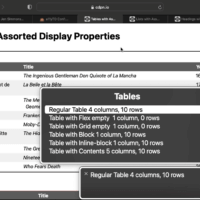Under-Engineered Patterns for #WCBUF

The slides for my talk are available as a

The slides for my talk are available as a

Thirty years ago, on April 30 1993, European Organization for Nuclear Research (CERN) announced the World Wide Web project. While the web existed before then, this marks its release into the public domain. The six images represent Mosaic 1.0 viewing the original versions of The World Wide Web project, Technical…

This post is about exposing field errors programmatically. I have already shared some opinions (such as a caution about displaying messages below fields or avoiding default browser field validation), but this post dives into using ARIA to convey them to screen reader users. With fields that produce error messages on…

Spanned table headers are not well supported across screen readers. While you can visually style these all sorts of ways to make the spanning clear, I am focusing on the programmatic outcomes. Which essentially means how they are exposed to screen reader users. This post uses only HTML <table>s. It…

First, a very important qualifier — this does not represent how Braille display users experience the web. All this post does is show how to enable the Braille display emulators in JAWS, NVDA, and VoiceOver. This can be handy when testing issues reported by users and you do not have…

TL;DR: Support for aria-readonly is nearly non-existent for the roles I tested. Should you need it, you cannot rely on it. You will be better off revising the pattern where you think you need it. For some background, the aria-readonly property: Indicates that the element is not editable, but is…

Now that it is a market differentiator to talk about accessibility in projects, that’s all many do — talk about it. In a sea of pop-dev noise, “accessibility” can be claimed with little risk someone will challenge it. If someone does, the response is often a fine balance between silence…

The slides for my talk are available as a

It was late 2020 when I last tested how browsers use CSS display properties to break the semantics of elements. I had been waiting for Safari to fix how it handles display: contents for four years now, and was excited when the announcement came in June. Then I started testing…

At the start of 2016 I wrote Internet Explorer Does Not Go Away Today because back then IE up to version 11 was being retired. But not Internet Explorer 11. I asked an AI (Neural Blender) to give me a picture of the Internet Explorer logo on fire. It’s almost…

I have spent a few years banging on about ensuring scrolling areas on a page are accessible to keyboard-only users. This is partly because the term “keyboard” maps to other input types that we distill to “keyboard” for ease of reference (speech input, sip-and-puff, on-screen keyboards, scanning software, etc.). When…

9 May 2023: The 2.5.8 language has changed. For the latest bookmarklet and language, skip ahead to the 9 May update. The proposed WCAG version 2.2 has gone through a bunch of revisions since I covered the first draft in 2020. One new success criterion that persisted is 2.5.8 Target…